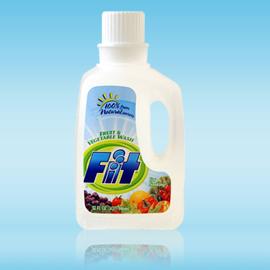Food is 21st century snake oil. In an era of unprecedented affluence, consumers now choose among a cacophony of low fat, enhanced nutrient staples reflecting a range of political statements and perceived lifestyle preferences, far beyond dolphin free tuna.
 On May 17, 2001, Procter & Gamble announced that it was discontinuing its Fit Fruit & Vegetable Wash in the United States, Canada and Mexico effective September 28, 2001. The company said the market was too small for continued investment.
On May 17, 2001, Procter & Gamble announced that it was discontinuing its Fit Fruit & Vegetable Wash in the United States, Canada and Mexico effective September 28, 2001. The company said the market was too small for continued investment.
But FIT is still out there. And someone e-mailed me about it the other day.
I’m not up on the current version of Fit being marketed, but in fall 2000, I contacted P&G to ask for the data substantiating the claim that Fit would eliminate 99.9 per cent of bacteria on fresh produce,
After a bunch of calls to various PR types I got hooked up with some scientists at P&G in Cincinnati, who verbally told me that sample cucumbers, tomatoes and the like were grown on the same farm in California, sprayed with chemicals that would be used in conventional production, and then harvested immediately and washed with Fit or water. The Fit removed 99.9 per cent more, or so the company claimed, because no data was ever forthcoming.
One problem. Many of the chemicals used have harvest after dates, such as the one tomato chemical that must be applied at least 20 days before harvest. Residue data on produce in Canadian stores reveals extremely low levels, in the parts per million or billion. So that 99.9% reduction is really buying consumers an extra couple of zeros in the residue quantity, all well below health limits.
No idea what the new Fit is promoting. But pathogens and chemicals in fresh produce need to be controlled on the farm, and in transportation and distribution.
